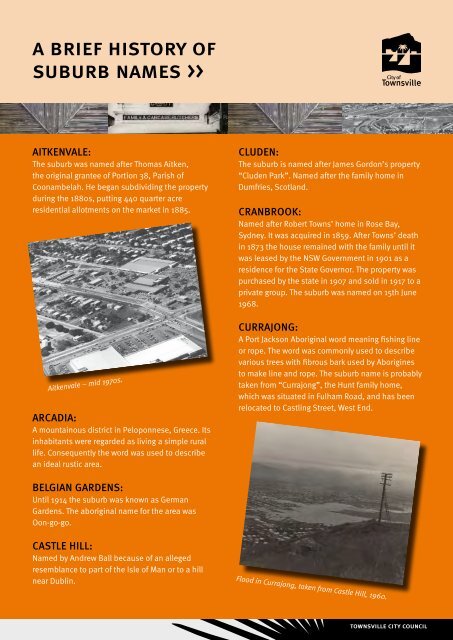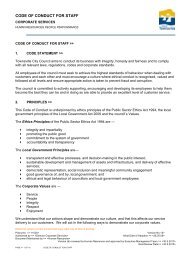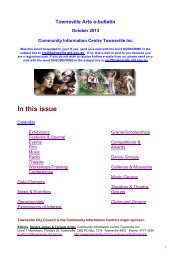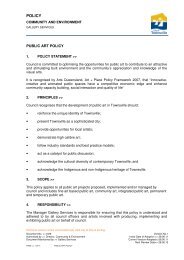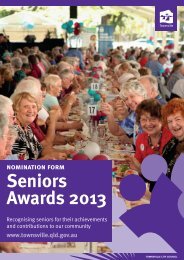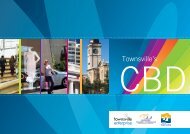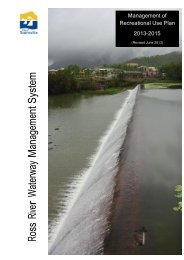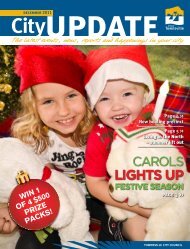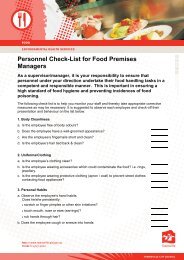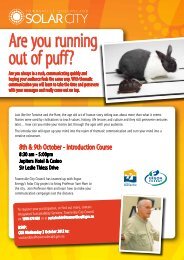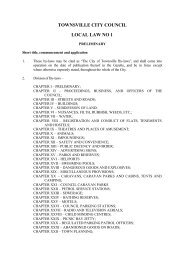a brief history of suburb names >> - Townsville City Council
a brief history of suburb names >> - Townsville City Council
a brief history of suburb names >> - Townsville City Council
- No tags were found...
Create successful ePaper yourself
Turn your PDF publications into a flip-book with our unique Google optimized e-Paper software.
a <strong>brief</strong> <strong>history</strong> <strong>of</strong><strong>suburb</strong> <strong>names</strong> >>AITKENVALE:The <strong>suburb</strong> was named after Thomas Aitken,the original grantee <strong>of</strong> Portion 38, Parish <strong>of</strong>Coonambelah. He began subdividing the propertyduring the 1880s, putting 440 quarter acreresidential allotments on the market in 1885.CLUDEN:The <strong>suburb</strong> is named after James Gordon’s property“Cluden Park”. Named after the family home inDumfries, Scotland.CRANBROOK:Named after Robert Towns’ home in Rose Bay,Sydney. It was acquired in 1859. After Towns’ deathin 1873 the house remained with the family until itwas leased by the NSW Government in 1901 as aresidence for the State Governor. The property waspurchased by the state in 1907 and sold in 1917 to aprivate group. The <strong>suburb</strong> was named on 15th June1968.Aitkenvale – mid 1970s.ARCADIA:A mountainous district in Peloponnese, Greece. Itsinhabitants were regarded as living a simple rurallife. Consequently the word was used to describean ideal rustic area.CURRAJONG:A Port Jackson Aboriginal word meaning fishing lineor rope. The word was commonly used to describevarious trees with fibrous bark used by Aboriginesto make line and rope. The <strong>suburb</strong> name is probablytaken from “Currajong”, the Hunt family home,which was situated in Fulham Road, and has beenrelocated to Castling Street, West End.BELGIAN GARDENS:Until 1914 the <strong>suburb</strong> was known as GermanGardens. The aboriginal name for the area wasOon-go-go.CASTLE HILL:Named by Andrew Ball because <strong>of</strong> an allegedresemblance to part <strong>of</strong> the Isle <strong>of</strong> Man or to a hillnear Dublin.Flood in Currajong, taken from Castle Hill, 1960.
a <strong>brief</strong> <strong>history</strong> <strong>of</strong><strong>suburb</strong> <strong>names</strong> >>GARBUTT:The <strong>suburb</strong> developed around Garbutt Siding,which was named by the Railway Department asthe siding provided rail access to Garbutt Brothersabattoir. Garbutt Brothers were well-known earlypastoralists and butchers. In July 1939 the GarbuttSiding Progress Association successfully petitionedthe government to change the name to Garbutt.HERMIT PARK:Robert Towns was the original owner <strong>of</strong> the land,which contained his boiling down works and cotton/sugar plantation. Leo Ferdinand Sachs, one-timemanager <strong>of</strong> the Australian Joint Stock Bank, purchasedthe “Boiling Down Paddock” from the estate <strong>of</strong> thelate Robert Towns in 1877. He placed a notice in the<strong>Townsville</strong> Herald on 6th July 1878 which gave hisaddress as “Hermit Park (late Boiling Down Paddock),apply at the Lodge.” He was still using “Hermit Park”as an address in 1883. The name Hermit Park is saidto be derived from a bachelor establishment there, <strong>of</strong>which Sachs was the head. In 1884 a syndicate formedthe <strong>Townsville</strong> Land and Investment Company topurchase the property for subdivision.HORSESHOE BAY:Magnetic Island. Named because <strong>of</strong> its shape. In1922, the <strong>Council</strong> suggested that the townshipat Horseshoe Bay be known as Bee-Ran, theAboriginal name <strong>of</strong> the bay.Garbutt Bros Ltd – Family butchersGULLIVER:Named after Ben Gulliver, nurseryman, who in the1890s was the proprietor <strong>of</strong> the Acacia Vale Nurseryand Pleasure Gardens which were located where theVilla Vincent Home now stands. He also had gardensat Sussex Street, Hyde Park and Stuart. The layout<strong>of</strong> the <strong>suburb</strong> was designed by Brisbane architectKarl Langer. This area was previously known asArmstrong’s Paddock.HEATLEY:The <strong>suburb</strong> was named after William John Heatley,mayor <strong>of</strong> <strong>Townsville</strong> from 1927 to 1932. He wasmanaging director <strong>of</strong> the family business <strong>of</strong> F.Heatley and Sons.HYDE PARK:The <strong>suburb</strong> <strong>of</strong> Hyde Park was named in the1880s (by the subdividers <strong>of</strong> the land) after HydePark, London which lies between Park Lane,Knightsbridge, Kensington Gardens and BayswaterRoad. The park was once part <strong>of</strong> the Manor <strong>of</strong> Hyde.From Castle Hill – early 1930s. West End in foreground,Hermit Park, Hyde Park, Mysterton & Pimlico inBackground.
a <strong>brief</strong> <strong>history</strong> <strong>of</strong><strong>suburb</strong> <strong>names</strong> >>IDALIA:In ancient times Idalia was the name <strong>of</strong> a river <strong>of</strong>Cyprus which flows into Famagusta Bay. It is knownas the Yalias River. The <strong>suburb</strong> was developed bythe Idalia Estate Land Company.MELTON HILL:Named after John Melton Black, one <strong>of</strong> the founders<strong>of</strong> <strong>Townsville</strong>, whose home was built on the crest<strong>of</strong> Melton Hill. The name was used at the first landsale <strong>of</strong> <strong>Townsville</strong> land held in Bowen in 1865.MOUNT LOUISA:The mountain itself was originally named by AndrewBall after a lady <strong>of</strong> his acquaintance. The Aboriginal<strong>names</strong> recorded by Charles Price in 1885 were Goobal-a-boroand Moor-ee-roon.MUNDINGBURRA:The name developed from Mun-dine-bo-ro whichwas the local Aboriginal name for the Rising Sundistrict recorded by Charles Price in 1885.MYSTERTON:The <strong>suburb</strong> takes its name from ‘Myseterton’, theresidence <strong>of</strong> Arminius Danner, which was situatedin St Johns Wood Estate subdivision <strong>of</strong> the late1880s. It was here in March 1891 that Joseph Hodelmarried Effie Waldie, his third wife. During itssubdivision in the 1920s, the <strong>suburb</strong> was known asMysterton Estate.NELLY BAY:Magnetic Island. First known as Bright’s Bay, it wasrenamed after Henry Butler’s daughter, Mrs NellyFraser who managed a guest house at Picnic Bay.Originally the name was spelt ‘Nellie’.NORTH WARD:Suburb <strong>of</strong> <strong>Townsville</strong> which derives its name fromthe electoral division <strong>of</strong> the same name - gazettedon 17th January 1880. The <strong>suburb</strong> was originallyknown as <strong>Townsville</strong> North.OONOONBA:An aboriginal word said to mean ‘swampy ground’.The original name for the <strong>suburb</strong> was Fairfield.Mundingburra 1963. Note: Pimlico High School,Andersen Park and Kokoda Pool in background.Brown and Broad’s timber yard Pimlico 1957/58.Note: Hyde Park Centre later built on this site.
a <strong>brief</strong> <strong>history</strong> <strong>of</strong><strong>suburb</strong> <strong>names</strong> >>PALLARENDA:The <strong>suburb</strong> takes its name from Cape Pallarenda,named in 1864 by Lieutentant GP Heath, duringhis survey <strong>of</strong> Cleveland Bay. As James Morrill wasaboard the ‘Flora’ during the survey and advisedHeath on other Aboriginal place <strong>names</strong>, it ispresumed that Pallarenda is an Aboriginal name. Itsmeaning is not known.PICNIC BAY:A popular picnic place and excursion destinationfrom the earliest days <strong>of</strong> settlement and takes itsname from these activities. The local Aboriginalname <strong>of</strong> the bay was Ca-moo-milli (Price, 1885) andCamoomilli was the <strong>of</strong>ficial name used for the firsttown on the island established at Picnic Bay. Thename <strong>of</strong> the town was <strong>of</strong>ficially changed to PicnicBay in 1963.PIMLICO:The <strong>suburb</strong> is named after a district <strong>of</strong> London,between Chelsea and Westminster in the <strong>City</strong> <strong>of</strong>Westminster.RAILWAY ESTATE:The <strong>suburb</strong> takes its name from the Railway Estatesubdivision developed by Messrs. Griffith andPurves during the mid 1880s. They purchased theland from L.F. Sachs who acquired the property in1877 from the Estate <strong>of</strong> the late Robert Towns.ROSSLEA:The <strong>suburb</strong> is named after John Deane’s property<strong>of</strong> the same name. John Deane served on manypolitical and community boards and committees.He was appointed to the Legislative <strong>Council</strong> in1889, which he continued to serve until his deathin 1913.ROWES BAY:In a letter to the <strong>Council</strong> dated 18th July 1967,the Queensland Place Names Board stated thatthe bay had been named Rowes Bay in 1864.The proclamation dated the 8th March 1866establishing the Municipality <strong>of</strong> <strong>Townsville</strong> refers tothe bay as ‘Ross Bay’. However, for the next eightyyears the name used on <strong>of</strong>ficial plans, maps andcharts <strong>of</strong> <strong>Townsville</strong> and its environs was ‘RoseBay’. Only after the Second World War did the nameRowes Bay come into general use. Charles SevilleRowe was one <strong>of</strong> the first settlers at Cleveland Bay.SOUTH TOWNSVILLE:Part <strong>of</strong> Ross Island, the <strong>suburb</strong> takes its name fromMessrs. Griffith and Purves’ South <strong>Townsville</strong> Estatesubdivision.STANTON HILL:Named after George Henry Stanton, the firstAnglican Bishop <strong>of</strong> North Queensland.STUART:The <strong>suburb</strong> is named after W. Clarendon Stuart(1833-1912), surveyor. Following the opening <strong>of</strong>the Kennedy district to settlement he surveyed thetowns <strong>of</strong> Bowen (1861), Wickham (1863), Dalrymple(1864) and <strong>Townsville</strong> (1865).
a <strong>brief</strong> <strong>history</strong> <strong>of</strong><strong>suburb</strong> <strong>names</strong> >>VINCENT:The <strong>suburb</strong> is named after William Slade Vincent,the principal <strong>of</strong> WS Vincent and Company, stock,station and land agents <strong>of</strong> <strong>Townsville</strong>. He was alsoa director <strong>of</strong> the <strong>Townsville</strong> Omnibus Company.From 1886 to 1890 he was the Major-in-Charge <strong>of</strong>the Third Queensland (Kennedy) Regiment. In 1888he was granted six months leave <strong>of</strong> absence toproceed to Suakim, in the Sudan, for active dutywith the British forces. He sailed from <strong>Townsville</strong> onthe SS Quetta on 1st January 1889 but there is norecord <strong>of</strong> his return.WULGURU:The <strong>suburb</strong> name is taken from Wulgurukaba, thename <strong>of</strong> the Aboriginal tribe which occupied thePalm Islands, Magnetic Island and the area fromthe Black River, east almost to Cape Cleveland andwest for about thirty kilometres beyond <strong>Townsville</strong>.WEST END:Originally the <strong>suburb</strong> was known as <strong>Townsville</strong>West, but by the 1920s the name West End was incommon use.Railway Estate with Castle Hill, West End andNorth Ward in the background.All images courtesy <strong>of</strong> the <strong>Townsville</strong> Library Photographic Collection.All Text extracted from <strong>Townsville</strong> Library Services “Highways and Byways” 1995.


